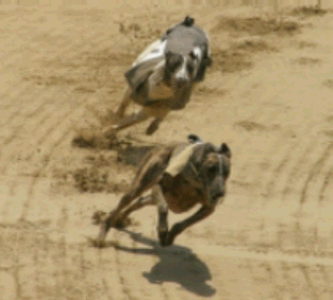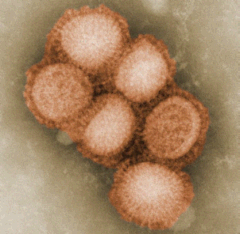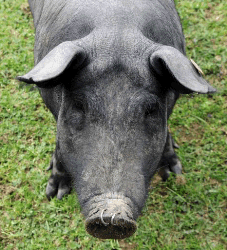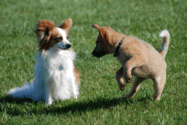|
CANINE INFLUENZA (H3N8 AND H3N2)

|
On March 31st, 2017 the Veterinary Public Health Department of Los Angeles County
announced an outbreak of H3N2 (Asian dog influenza).
This was followed by a much larger outbreak July through October 2021.
In 2015, a new strain of canine flu entered the U.S. from Asia,
this time more virulent and more contagious among dogs
than the flu from the racing industry.
They recommend that all dogs that interact with other dogs receive the H3N2 vaccine.
H3N8 (the flu from the racing industry) may now be extinct in the U.S.
|
|
|
Influenza viruses of an assortment of varieties have been the subject of concern for humans, wildlife, and domestic animals for many decades. The dog was largely felt to be exempt from “the flu” until 2004 when a new canine influenza virus, clearly stemming from the equine influenza virus, was isolated from several groups of Florida racing greyhounds. The problem seemed confined to the racing industry until 2005 when cases began appearing in boarding facilities involving pet dogs. In 2015, a new strain of canine flu entered the U.S. from Asia this time more virulent and more contagious among dogs than the flu from the racing industry. This epidemic (more correctly called an "epizootic") centered around Chicago, leading to sickness in over 1000 dogs despite widespread quarantine. Since then several more outbreaks have been recorded around the United States. At present, it is these two strains of canine influenza that concern dogs: H3N8 (from the racing industry) and H3N2 (from Asia). The following information includes a basic primer on what they are and how to keep your pets safe as well as some basics on influenza that apply to both canine and human flu infections.
CANINE INFLUENZA PRODUCES COUGH, FEVER, AND PNEUMONIA
WHICH CAN BE LIFE-THREATENING.
DOGS ARE MOST CONTAGIOUS DURING THE 2-4 DAY INCUBATION PERIOD
(BEFORE THEY SHOW ANY SYMPTOMS)
AND ARE CONTAGIOUS TO OTHER DOGS FOR AT LEAST 3 WEEKS.
|

The original canine flu in the U.S.
started with racing greyhounds.
(Photo Credit: Alex Lapuerta via Wikimedia Commons) |
WHAT IS CANINE INFLUENZA AND WHAT DO THE "H" AND "N" LETTERS MEAN?
|
Let's start with what an influenza virus is. There are actually three types (genera) of influenza viruses: type A (including the canine influenza viruses), type B, and the less closely related Type C. They all produce fever, joint pain, and respiratory signs with which we are all familiar. Death is unusual but stems from respiratory complications and is most common in the very old and very young. Most human flu viruses are type B or C.
The Type A influenza virus has on its surface an assortment of proteins which determine its “strain” or subtype, and it is against these surface proteins that our bodies mount an immune response. Of particular note are the hemaglutinin proteins and neuramindase proteins for which specific strains of influenza viruses are named. For example, in 2009, there was a human epidemic of "H1N1" virus. The canine influenza viruses are "H3N8" and "H3N2." As human influenzas emerge, these terms may be in the news and it is of interest to know what they refer to. If a viral strain mutates and sufficiently changes its surface proteins, a new strain is created. A new strain is one where the susceptible population has no immunity and infection can spread rapidly.
|

Group of influenza viruses
(Photo Credit: CDC Public Health Image Library)
|
ANTIGENIC DRIFT AND ANTIGENIC SHIFT: WHY PEOPLE NEED A DIFFERENT FLU SHOT EVERY YEAR BUT DOGS DON'T
Influenza viruses have a unique ability to mutate and form new strains. This process of change is called "antigenic drift" and produces new strains of influenza that infect the same host species. (It is because of antigenic drift that we need a new vaccine for flu each flu season.) Sometimes these mutations, lead to a strain being able to cross over into a new species like the way Asian canine influenza can infect cats.
Every time anyone gets infected with a flu virus, the virus replicates as part of the infection process and with each replication there comes an opportunity for the virus to mutate/drift. In human flu season, thousands of people are infected. Consider how many people you come into contact with casually in a typical day. There are co-workers, family members, people waiting in assorted lines with you, people on public transportation with you, customers, people on the street etc. This is a great deal of potential contagion daily and a great deal of potential antigenic drift.
Now think of how many other dogs your dog comes into contact with daily. Many dogs do not contact dogs beyond their own housemates. Others might see occasional other dogs on walks. Others may go to grooming or day care and see many other dogs. Still, it is easy to see that most dogs do not have the same potential for contagion that people do. For this reason, canine influenza vaccine can remain largely the same year after year.
|
As fear of flu pandemics arises, it is worth mentioning another situation: antigenic shift. Type A influenza viruses can actually reorganize their surface proteins to facilitate crossing from one species to another and thus creating of a vastly different different new flu virus. This process of change is called "antigenic shift" and usually occurs within the body of a bird or pig. The new viruses that are created by this process are more likely to be able to jump to a new species than those created by the simple mutations of antigenic drift (which is why "swine flu" and "avian flu" are portrayed as particularly ominous in relation to human infection).
Despite all this mutation and recombining, influenza viruses generally keep to the same host species. Neither of the two canine influenza viruses is transmissible to humans. The H3N2 (Asian) canine influenza virus is able to infect cats as can the H7N3 (avian) influenza virus. The H3N8 canine influenza virus has not been known to infect cats. The H1N1 influenza virus that was involved in the human pandemic of 2009 can also infect cats but cats do not shed virus back in amounts likely to infect humans. As a general rule, humans infect other humans; household pets are not involved in transmission of flu to humans.
|
 (Photocredit: Morguefile.com) (Photocredit: Morguefile.com) |
WHAT HAPPENS TO THE SICK DOGS?
Infection rate is high but (depending on which report one reads) 20-50% will simply make antibodies and clear the infection without any signs of illness at all.
The other 50-80% will get symptoms of the “flu:” they will have fevers, listlessness, coughing, and a snotty nose. Most dogs will recover with supportive treatment (antibiotics, perhaps nebulization/humidification, etc.). A small percentage of dogs will actually get pneumonia. These dogs are those at risk for death and support becomes more aggressive: hospitalization, intravenous fluid therapy etc. Most of these dogs will recover as well, as long as they receive proper care. Mortality rate is 5-8%
The incubation period is 2-5 days and the course of infection lasts 2-4 weeks. Because this is an emerging disease, few dogs will have immunity to it unless they have received one of the new vaccines. This means that any dog unvaccinated for influenza is a candidate for infection.
- The point is not to ignore a coughing dog.
- Do not allow your dog to socialize with coughing dogs. If your dog develops a cough, see your veterinarian.
- If your dog develops a snotty nose, listlessness, and cough do not be surprised if your veterinarian wants to look at chest radiographs and considers hospitalization. More routine forms of Kennel Cough do not produce fever or listlessness.
HOW IS THE DISEASE TRANSMITTED?
|

(photocredit: MorgueFile.com)
|
Dogs that are infected will shed virus in body secretions whether or not they appear to be sick. Virus transmission can occur from direct contact with an infected dog or with its secretions. Kennel workers have been known to bring the virus home accidentally to their own pets. The virus persists on toys, bowls, collars, leashes etc. for several days. Infected animals intermittently shed virus for up to 24 days.
|
HOW ARE SICK DOGS TREATED?
High fevers are treated with anti-pyretic medications or cool water baths, but generally antibiotics to control secondary infections are all that is needed as long as there is no actual pneumonia. Pneumonia results from secondary bacterial infections (i.e. bacteria invading the lung after the virus has damaged the tissue and compromised its ability to defend itself) and requires more aggressive support such as intravenous fluids, injectable antibiotics and possibly supplemental oxygen if it is severe enough. For details click here.
CAN DOGS GET REINFECTED?
After a dog has recovered from canine influenza, immunity appears to last at least 2 years.
HOW ARE DOGS TESTED FOR CANINE INFLUENZA?
In a perfect world there would be a simple test that could be performed on a single sample and yield unequivocal results. There are two main ways to confirm canine influenza infection:
- PCR Testing
PCR testing is a method of testing involving amplifying small samples of DNA to make them more easily detectable. A nasal or throat swab is used for the sample but timing is crucial; the sample must be obtained 3-4 days after the onset of symptoms. Because timing is difficult, this method may not be accurate.
- Serology
Here, a blood sample is tested for antibodies against canine influenza virus and the antibody level is compared to that from a second sample taken later. The first sample is drawn within one week of the onset of symptoms and the second sample is drawn 2-3 weeks later. If the second sample shows a four-fold increase in antibody level, this indicates a true infection has occurred. This means, inconveniently, that diagnosis cannot be confirmed for several weeks after the dog has gotten sick. A single sample with antibodies present only indicates that the dog has been exposed to influenza and does not clarify whether the infection is current, recent or in the long past.
Negative test results are not felt to rule out a diagnosis of canine influenza infection.
- ELISA test
Test kits are available to detect human flu virus in a matter of minutes at the doctor's office. These kits will also work to detect canine influenza virus in a canine nasal swab. False negatives may be a problem but a positive result can be trusted. Some veterinary offices are using these kits for their coughing canine patients.
DOES VACCINATION AGAINST “KENNEL COUGH” (BORDETELLA) OR PARAINFLUENZA OFFER ANY PROTECTION AGAINST CANINE INFLUENZA?
No. In fact, H3N8 requires a separate vaccine from H3N2, though both can be combined into one injection (a "bivalent" vaccine). After the H3N2 outbreak of 2015 in Chicago, this virus has popped up in other areas. International dog rescue has become more common which provides more opportunity for introduction of H3N2. Vaccination has been uncommon, though, this may change. The flu is no fun for anyone and has potential to be life-threatening. As of 2025, the importance of vaccinating for H3N8 (from the racetrack) has become more controversial as this strain has not been reported since 2016.
In most influenza situations, it is the very young and very old who experience the most severe disease but during the H3N2 outbreak, most infected dogs were healthy and middle-aged.
INFLUENZA AND PARAINFLUENZA ARE COMPLETELY DIFFERENT VIRUSES.
|
|
Vaccination against influenza will not prevent infection.
It will, however, greatly reduce symptoms and potential for contagion.
|
|
|
CAN PEOPLE GET INFECTED?
People cannot get infected by this virus. Influenza viruses are specific for their host species and require a dramatic mutation in order to jump species. One should not be concerned about getting an influenza infection from a dog, horse, or any other species other than a fellow human being.
For additional information, see the links below:
Merck Animal Health has additional information on the Canine Influenza at:
www.dogflu.com
Zoetis page for pet owners on Canine Influenza:
http://cloud.mc.zoetis.com/BIOS-CIV-Questions

Page last updated: 6/15/2025
|